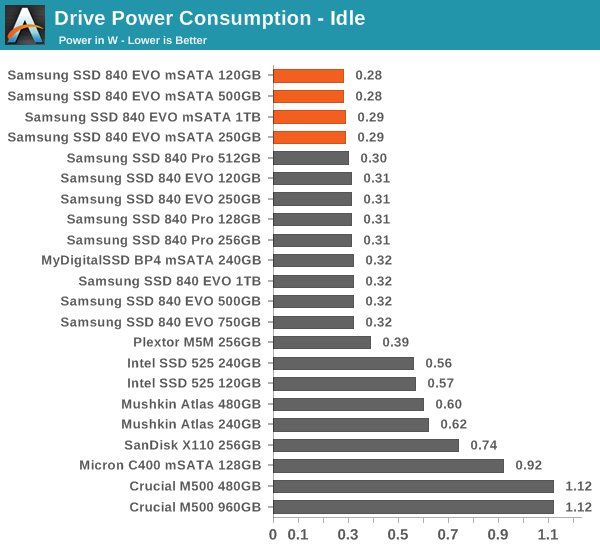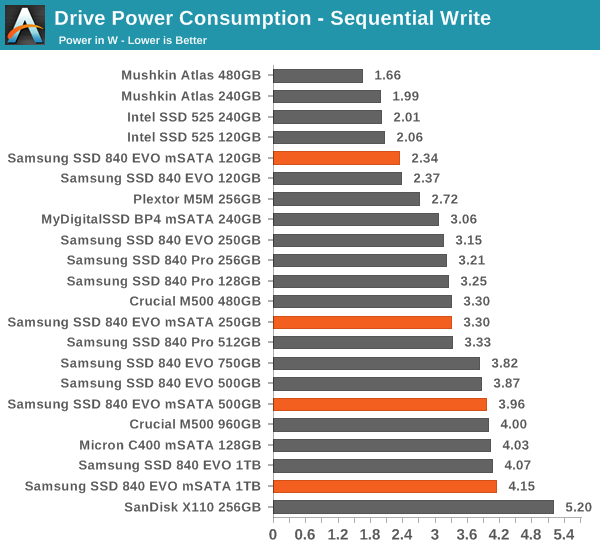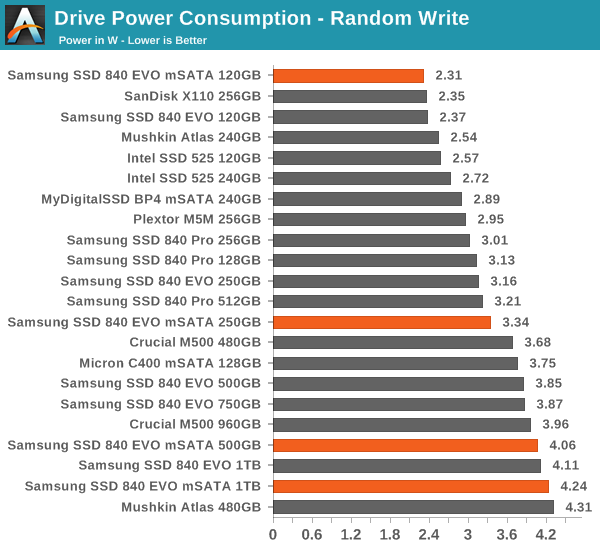Samsung SSD 840 EVO mSATA (120GB, 250GB, 500GB & 1TB) Review
by Kristian Vättö on January 9, 2014 1:35 PM ESTPower Consumption
One problem we have with testing mSATA SSDs is the fact that they require an mSATA to 2.5" adapter with a voltage regulator since 2.5" SATA is 5V whereas mSATA spec is rated at 3.3V. If you were to connect an mSATA SSD to a native mSATA slot, the power supply would automatically provide the drive with a voltage of 3.3V (SATA spec has three voltage rails: 3.3V, 5V and 12V) but because we have to deal with an adapter, the current we're measuring is based on the 5V rail (which the voltage regulator then changes to 3.3V). The voltage itself isn't the issue because it's fairly safe to assume that the adapter provides 3.3V to the drive but figuring out the difference between the input and output currents of the voltage regulator is. With the help of one of our readers (thanks Evan!), we were able to find out that the delta between input and output currents is typically 8mA (i.e. 0.008A) in the voltage regulator used in our adapter. Our measurements confirmed that as the adapter drew 8mA without a drive connected to it, although under load the regulator may draw a little more than that (datasheet claims a maximum of 20mA).
As we now know the difference between the input and output currents (current on 5V rail minus 8mA) as well as the voltage of the drive (3.3V), we're able to measure the actual power consumed by the drive. I've updated all mSATA SSD results to correspond with the change, so the number's you're seeing here are different from the ones you've seen in earlier reviews.
The EVO mSATA has great power characteristics, just like it's 2.5" sibling. There's no significant difference between the two and overall the EVO mSATA is one of the most power efficient mSATA drives. Unfortunately I don't have the necessary equipment to test slumber power consumption (HIPM+DIPM enabled) but I'd expect the EVO mSATA to have numbers similar to the 2.5" EVO (see the chart here).
The numbers here are worst-case scenarios and something I noticed during testing was that it takes a while for EVO to reach its maximum power draw. With the 500GB and 1TB models, the power draw was ranging between 2.2W and 2.5W for up to 30 seconds or so until it jumped to over 4W. I'm guessing this is due to TurboWrite because there is less NAND in use when the SLC buffer is employed (you simply don't need as many die to achieve high performance since program/erase times are much shorter). Once the buffer is full, the drive has to start writing to the TLC portion of the NAND, which increases the power draw as more NAND is in use. The downside is once you stop writing, the drive will keep drawing high power for a while in order to move the data from the SLC buffer to the TLC NAND. For example the 1TB model kept drawing ~3.5W for about a minute after I had stopped writing to the drive. I like Samsung's method because the garbage collection is done immediately instead of waiting for long idle periods like some manufacturers do -- doing garbage collection actively recovers performance quicker whereas it may take hours for idle garbage collection to kick in.













65 Comments
View All Comments
wingless - Thursday, January 9, 2014 - link
1TB in that small package?! 2014 is really the FUTURE! This will turn my laptop into a monster.Samus - Thursday, January 9, 2014 - link
What's interesting is it isn't even worth considering these models UNLESS you go with 1TB, because all the other capacities aren't nearly price competitive with the competition. Fortunately for Samsung, there is no competition at the flagship capacity, so they could charge whatever they want.Kristian Vättö - Friday, January 10, 2014 - link
Like I said, those are MSRPs, not street prices. The MSRPs of the 2.5" EVO are only $10 less but as you can see, the street prices are significantly lower.TheSlamma - Wednesday, January 15, 2014 - link
it's the presentjaydee - Thursday, January 9, 2014 - link
Hard for me to justify the 48-55% price premium of the 840 EVO over the Crucial M500 (250 GB and 500 GB versions). At some point "faster" SSD's hits diminishing returns in "real life" scenario's...fokka - Thursday, January 9, 2014 - link
"I wasn't able to find the EVO mSATA on sale anywhere yet, hence the prices in the table are the MSRPs provided by Samsung. For the record, the MSRPs for EVO mSATA are only $10 higher than 2.5" EVO's, so I fully expect the prices to end up being close to what the 2.5" EVO currently retails for."meaning: the prices will go down, once broadly available.
emn13 - Thursday, January 9, 2014 - link
On the desktop? Given the lack of power-loss protection, the 840 EVO is probably a worse choice even at comparable prices.But on mobile? Sudden power loss is less likely (though background GC complicates that picture), and the 840 EVO's lower power draw, particularly in idle, extends battery life.
I'm pretty sure I'd opt for the 840 EVO on a battery-powered device, assuming the price difference isn't too great.
nathanddrews - Thursday, January 9, 2014 - link
If it helps your decision at all, I just upgraded my wife's notebook (Lenovo Y580) from a 2.5" 250GB Samsung 840 (not pro) to an mSATA 240GB Crucial M500 (and then put the stock 750GB HDD back in) and it's phenomenal. The M500 feels snappier, but that could just be due to restoring the existing Windows image onto a clean drive. Either way, it was a great $130 upgrade.If you have a free mSATA port on your notebook, it's a no-brainer to get an SSD for it.
Solid State Brain - Thursday, January 9, 2014 - link
The trim behavior might be something introduced with one of the latest firmwares. I have a Samsung 840 250GB and I recently tried doing some steady state tests. After hammering it with writes, trim does not restore performance immediately. However with normal usage/light workloads, or keeping the drive idle, however, it will eventually (in a matter of hours) return back to the initial performance.I guess this is some kind of strategy to improve long term wear/stability/write endurance. Maybe some sustained write protection kicks in to avoid writing immediately at full speed after trimming the free space.
Solid State Brain - Thursday, January 9, 2014 - link
PS: where's the edit button to fix typos/errors, etc, when needed?? :(